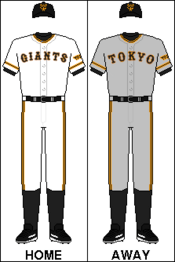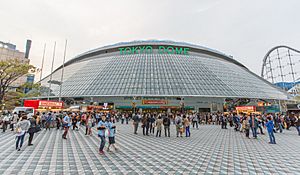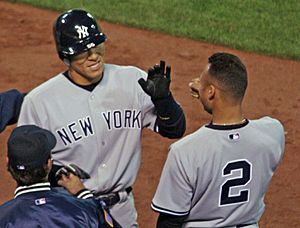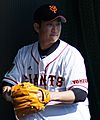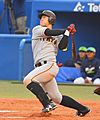Yomiuri Giants facts for kids
Quick facts for kids Yomiuri Giants |
|||||
|---|---|---|---|---|---|
|
|||||
| Information | |||||
| League | Nippon Professional Baseball
|
||||
| Location | Bunkyō, Tokyo, Japan | ||||
| Ballpark | Tokyo Dome | ||||
| Year founded | December 26, 1934 | ||||
| Nickname(s) | Kyojin (巨人, 'Giants') | ||||
| CL pennants | 39 (1951, 1952, 1953, 1955, 1956, 1957, 1958, 1959, 1961, 1963, 1965, 1966, 1967, 1968, 1969, 1970, 1971, 1972, 1973, 1976, 1977, 1981, 1983, 1987, 1989, 1990, 1994, 1996, 2000, 2002, 2007, 2008, 2009, 2012, 2013, 2014, 2019, 2020, 2024) | ||||
| Japan Series championships | 22 (1951, 1952, 1953, 1955, 1961, 1963, 1965, 1966, 1967, 1968, 1969, 1970, 1971, 1972, 1973, 1981, 1989, 1994, 2000, 2002, 2009, 2012) | ||||
| JBL championships | 9 (1936 Fall, 1937 Spring, 1938 Fall, 1939, 1940, 1941, 1942, 1943, 1949) | ||||
| Former name(s) |
|
||||
| Former ballparks |
|
||||
| Colors | Orange, Black, White |
||||
| Mascot | Giabbit | ||||
| Playoff berths | 14 (2007, 2008, 2009, 2010, 2011, 2012, 2013, 2014, 2015, 2016, 2018, 2019, 2021, 2024) | ||||
| Retired numbers | |||||
| Ownership | Legally as KK Yomiuri Kyojingun (株式会社読売巨人軍) 100% owned by The Yomiuri Shimbun Holdings | ||||
| Management | Toshikazu Yamaguchi | ||||
| Manager | Shinnosuke Abe | ||||
| Uniforms | |||||
|
|
|||||
The Yomiuri Giants are a famous Japanese professional baseball team. They play in the Nippon Professional Baseball's Central League. The team is based in Bunkyo, Tokyo, Japan. They play their home games at the Tokyo Dome. The Giants are owned by The Yomiuri Shimbun Holdings, a large media company in Japan.
The Giants are the oldest professional sports team in Japan. They are also the most successful. They have won 22 Japan Series titles. They also won nine titles before NPB was formed. Their biggest rival is the Hanshin Tigers. Many people call the Yomiuri Giants "The New York Yankees of Japan." This is because they are very popular and have won so many games. They have fans all over Japan, even in cities with their own teams.
The team's name and uniforms were inspired by the New York Giants baseball team in the United States. The Giants' colors are orange and black, just like the New York (and now San Francisco) Giants. The letters on their jerseys and caps look similar to the old New York Giants' style.
Contents
Team History
How the Giants Started
The team began in 1934. It was called The Great Japan Tokyo Baseball Club. This team was made of all-star players. They toured the United States and played against American all-star teams. These teams included famous players like Babe Ruth and Lou Gehrig. The team's owner, Matsutarō Shōriki, decided to make this group a professional team.
In 1935, the team went back to the United States. They played many games against college and minor league teams. They played 109 games in 128 days! The team won 75 games, lost 33, and had 1 tie.
During this tour, the manager of the San Francisco Seals, Lefty O'Doul, suggested a new name. He said "Tokyo Dai Nippon Baseball Club" was not exciting for Americans. He thought Tokyo was like New York in Japan. So, he suggested they be named after one of New York's baseball teams. Since "Yankees" was an American name, he suggested "Giants." The team liked the name and became the Tokyo Giants during the tour.
Tokyo Kyojin Era
In 1936, the Japanese Baseball League was formed. The team changed its name to the Tokyo Kyojin. This name is often translated as Tokyo Giants. They won eight league championships under this name. This included six championships in a row from 1938 to 1943.
Many great players played for the Tokyo Kyojin. Victor Starffin, a pitcher, was a star until 1944. He won two MVP awards and had 42 wins in 1939. Another great pitcher was Eiji Sawamura. He pitched the first no-hitter in Japanese professional baseball in 1936. He pitched two more no-hitters later. Sawamura was a brave player who served in the army during World War II. He returned to play between deployments. Sadly, he was killed in battle near the end of the war.
Tetsuharu Kawakami was a key player from 1938 to 1958. He won the batting title five times. He was the first Japanese pro baseball player to get 2,000 hits. He was named the league's MVP three times. Hideo Fujimoto was another amazing pitcher. He holds records for the lowest career ERA (1.90). He also pitched the first perfect game in Japanese professional baseball history.
Yomiuri Giants Era
In 1947, the team became the Yomiuri Giants. They won the last JBL championship in 1949. From 1938 to 1987, the Giants played at Korakuen Stadium. In 1988, they moved to their current home, the Tokyo Dome.
In 1950, the Giants helped start Nippon Professional Baseball. They joined the Central League. They won their first NPB championship in the 1951 Japan Series. They beat the Nankai Hawks 4 games to 2. The Giants continued to win Japan Series championships in 1952, 1953, and 1955.
Two of the most famous Giants players are Sadaharu Oh and Shigeo Nagashima. Oh played from 1959 to 1980. Nagashima played from 1958 to 1974. Their batting combination was called the "Oh-Nagashima Cannon." They were the best hitters in the league. The Giants, led by manager Tetsuharu Kawakami, won nine straight Japan Series championships from 1965 to 1973. This is known as the "V9 dynasty." During his career, Oh won the batting title five times and the home run title fifteen times. Nagashima won the MVP award five times.
Later, Shigeo Nagashima became the Giants' manager. He led them to Japan Series championships in 1994, 1996, and 2000. Another famous player, Hideki Matsui, played for the Giants for ten seasons. He was a three-time MVP. He helped his team win three Japan Series titles (1994, 2000, and 2002). He was nicknamed "Godzilla" because of his powerful hitting.
Rivalries
The Giants have big rivalries with other teams in the Central League. Their most famous rivalries are with the Hanshin Tigers, the Chunichi Dragons, and the Tokyo Yakult Swallows.
Giants-Tigers Rivalry
The rivalry between the Giants and the Hanshin Tigers is one of the most exciting in Japanese sports. It started on July 15, 1936. In one early game, Eiji Sawamura pitched the first no-hitter in Japanese professional baseball against the Tigers.
The Giants have often had more success than the Tigers. During the Giants' "V9 dynasty" (1965-1973), the Tigers often finished second in the league. As of the end of the 2024 season, the Giants have won more Japan Series championships (22-2) and Central League pennants (39-6) against the Tigers.
Tokyo Series: Giants vs. Swallows
The Giants also have a rivalry with the Tokyo Yakult Swallows. Both teams are based in Tokyo. This rivalry became more intense after 2006. The games between them are now called the "Tokyo Series."
Since 2006, the Giants have won more regular season games against the Swallows. Overall, since the Swallows started in 1950, the Giants lead the head-to-head record.
Giants-Dragons Rivalry
The rivalry between the Giants and the Chunichi Dragons is considered the oldest in Japanese professional team sports. They first played on February 5, 1936.
Like with the Tigers, the Giants have often been more successful than the Dragons. A famous game happened at the end of the 1994 NPB season. The Giants and Dragons were tied for first place. The Giants won that game, called the "10.8 Showdown," and then went on to win the 1994 Japan Series.
Roster
|
Yomiuri Giants roster
|
|||||||
|---|---|---|---|---|---|---|---|
| First squad | Second squad | ||||||
|
Pitchers
Catchers
|
Infielders
Outfielders
Manager
Coaches
|
Pitchers
Catchers
|
Infielders
Outfielders
Manager
Coaches
Organisational coach
|
||||
| Development Players | |||||||
|
|||||||
| Updated December 27, 2022 | → All NPB rosters | ||||||
Players of Note
Famous Former Players
 Shigeru Chiba (千葉 茂)
Shigeru Chiba (千葉 茂) Suguru Egawa (江川 卓)
Suguru Egawa (江川 卓) Tsuneo Horiuchi (堀内 恒夫)
Tsuneo Horiuchi (堀内 恒夫) Tetsuharu Kawakami (川上 哲治)
Tetsuharu Kawakami (川上 哲治) Masumi Kuwata (桑田 真澄) – P
Masumi Kuwata (桑田 真澄) – P Kazuhiro Kiyohara (清原 和博)
Kazuhiro Kiyohara (清原 和博) Hideki Matsui (松井 秀喜)
Hideki Matsui (松井 秀喜) Shigeo Nagashima (長嶋 茂雄)
Shigeo Nagashima (長嶋 茂雄) Sadaharu Oh (王貞治)
Sadaharu Oh (王貞治) Masaki Saito (斎藤 雅樹)
Masaki Saito (斎藤 雅樹) Eiji Sawamura (沢村 栄治)
Eiji Sawamura (沢村 栄治) Victor Starffin
Victor Starffin Yoshinobu Takahashi (高橋 由伸)
Yoshinobu Takahashi (高橋 由伸) Koji Uehara (上原 浩治)
Koji Uehara (上原 浩治) Wally Yonamine (与那嶺 要)
Wally Yonamine (与那嶺 要) Shinnosuke Abe (阿部 慎之助)
Shinnosuke Abe (阿部 慎之助)
Retired Jersey Numbers
The Giants have honored some of their greatest players by retiring their jersey numbers. This means no other player on the team can wear that number again.
- 1
 Sadaharu Oh (王貞治)
Sadaharu Oh (王貞治) - 3
 Shigeo Nagashima (長嶋 茂雄)
Shigeo Nagashima (長嶋 茂雄) - 4
 Toshio Kurosawa (黒沢 俊夫)
Toshio Kurosawa (黒沢 俊夫) - 14
 Eiji Sawamura (沢村 栄治)
Eiji Sawamura (沢村 栄治) - 16
 Tetsuharu Kawakami (川上 哲治)
Tetsuharu Kawakami (川上 哲治) - 34
 Masaichi Kaneda (金田 正一)
Masaichi Kaneda (金田 正一)
Top Players by Stats
Top Pitchers
| Player | Years | Wins | Strikeouts | ERA |
|---|---|---|---|---|
| Takehiko Bessho | 1949–1961 | 221 | 1372 | 2.20 |
| Teruzo Nakao | 1939–1957 | 209 | 1597 | 2.48 |
| Tsuneo Horiuchi | 1966–1983 | 203 | 1865 | 3.27 |
| Victor Starffin | 1936–1944 | 199 | 1225 | 1.37 |
| Hideo Fujimoto | 1942–1946, 1948–1955 | 183 | 1100 | 1.90 |
| Masaki Saito | 1983–2001 | 180 | 1707 | 2.77 |
| Masumi Kuwata | 1986–2006 | 173 | 1980 | 3.53 |
| Hiromi Makihara | 1982–2001 | 159 | 2111 | 3.19 |
Sourse:Nippon Professional Baseball League (NPB)
Top Hitters
| Player | Years | Hits | Homeruns | RBIs | Batting Average |
|---|---|---|---|---|---|
| Sadaharu Oh | 1959–1980 | 2786 | 868 | 2170 | .301 |
| Shigeo Nagashima | 1958–1974 | 2471 | 444 | 1522 | .305 |
| Tetsuharu Kawakami | 1938–1955 | 2351 | 181 | 1319 | .313 |
| Hayato Sakamoto | 2008–ongoing | 2205 | 266 | 944 | .291 |
| Shinnosuke Abe | 2001–2019 | 2132 | 406 | 1285 | .284 |
| Isao Shibata | 1962–1981 | 2018 | 194 | 708 | .267 |
Sourse:Nippon Professional Baseball League (NPB)
Top Home Run Hitters
| Rank | Player | Homeruns | Years |
|---|---|---|---|
| 1 | Sadaharu Oh | 868 | 1959–1980 |
| 2 | Shigeo Nagashima | 444 | 1958–1974 |
| 3 | Shinnosuke Abe | 406 | 2001–2019 |
| 4 | Tatsunori Hara | 382 | 1981–1995 |
| 5 | Hideki Matsui | 332 | 1993–2002 |
| 6 | Yoshinobu Takahashi | 321 | 1998–2015 |
| 7 | Hayato Sakamoto | 266 | 2008–ongoing |
| 8 | Isao Shibata | 194 | 1962–1981 |
Sourse:Nippon Professional Baseball League (NPB)
Recent Season Records
| Season | Games Played | Wins | Losses | Ties | Win % | Finish | Playoffs |
| 2019 | 143 | 77 | 64 | 2 | .546 | 1st, Central | Lost in Japan Series, 0–4 (Hawks) |
| 2020 | 120 | 67 | 45 | 8 | .598 | 1st, Central | Lost in Japan Series, 0–4 (Hawks) |
| 2021 | 143 | 61 | 62 | 20 | .496 | 3rd, Central | Lost in League Final Stage, 0–3 (Swallows) |
| 2022 | 143 | 68 | 72 | 3 | .514 | 4th, Central | Did not qualify |
| 2023 | 143 | 71 | 70 | 2 | .504 | 4th, Central | Did not qualify |
"Japan's Team"
The Yomiuri Giants are often called "Japan's Team." This is because the Yomiuri company, which owns the team, is a very large media company in Japan. For a while, the Giants' uniforms even said "Tokyo" instead of "Yomiuri." This made it seem like they represented the whole city of Tokyo.
Many people compare the Giants' popularity to teams like the New York Yankees in the U.S. or Real Madrid in soccer. A large number of baseball fans in Japan support the Giants. However, fans of other teams sometimes don't like the Giants' huge popularity. They feel the Giants get special treatment because of their owner's influence.
Some people also proudly remember a time from 1958 to 1974. During this period, the Giants won many championships without any foreign players.
MLB Players
Some players who played for the Yomiuri Giants have also played in Major League Baseball (MLB) in the United States.
- Active MLB Players (as of July 2025)
- Miles Mikolas (played for Giants 2015–2017)
- Matt Andriese (played for Giants 2022)
- Tomoyuki Sugano (played for Giants until 2024, joined MLB in 2025)
- Retired MLB Players who played for Giants
- Hideki Matsui (played for Giants until 2002, then MLB 2003–2012)
- Koji Uehara (played for Giants until 2008, then MLB 2009–2017)
- Masumi Kuwata (played for Giants until 2006, then MLB 2007)
Mascots
The Giants have six mascots called the Giabbits. They are based on an older Giants logo. There are two adult male mascots, Giabyi and Giabba. There is also an adult female mascot named Vicky. Two child mascots, Tsuppy (a boy) and Chappy (a girl), are also part of the group. The newest mascot, Grandpa Giabbit, was introduced in 2014. His jersey number is 1934, which is the year the team was founded.
Minor League Team
The Giants also have a farm team, which is like a training team for younger players. This team plays in the Eastern League. It was started in 1949.
Images for kids
-
Tetsuharu Kawakami in 1946
-
Three Giants stars of the 1950s: Tetsuharu Kawakami, Shigeru Chiba, and Noboru Aota (left to right)
See also
 In Spanish: Yomiuri Giants para niños
In Spanish: Yomiuri Giants para niños




